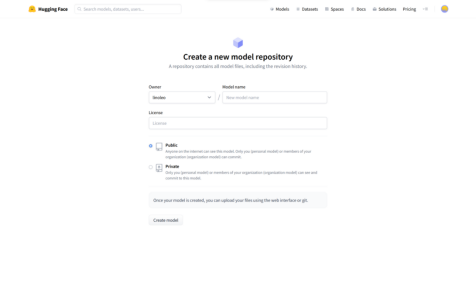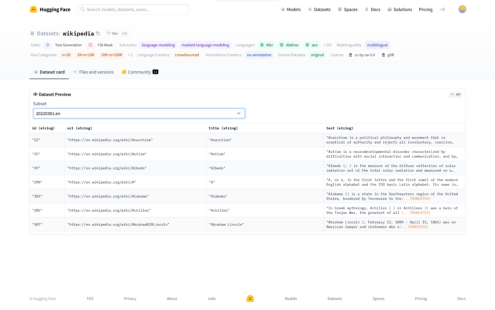Hugging Face AI: The Most Advanced Machine Learning Technology

In today's rapidly changing technological world, artificial intelligence (AI) has become a crucial field, fundamentally transforming and integrating into our daily lives. At the core of this AI wave is natural language processing (NLP), which powers popular conversational tools like ChatGPT and Bard. What if most of the models that make these tools possible were open to everyone and centralized in one place? Enter Hugging Face, a disruptor in the fields of machine learning and natural language processing, and a key driver of AI democratization.
What is Hugging Face?
If you are interested in artificial intelligence and natural language processing, you may have heard of Hugging Face, a company named after a cute emoji. Hugging Face is not just a company but a platform changing the AI and NLP landscape through open-source and open science. Anyone can use open-source code to create, train, and deploy NLP and ML models. Hugging Face provides a machine learning (ML) and data science platform and community that helps users build, deploy, and train machine learning models. By offering infrastructure for demonstrating, running, and deploying AI models in real-time applications, users can also browse models and datasets uploaded by others. Hugging Face is often referred to as the GitHub for machine learning because it allows developers to publicly share and test their work.

History of Hugging Face
Founded in 2016, Hugging Face initially started as a Franco-American company aiming to develop an interactive AI chatbot targeted at teenagers. However, after open-sourcing the chatbot's model, the company quickly shifted to a more ambitious vision: to provide powerful and easy-to-use tools for the AI industry.
The transformative Transformers library, launched in 2018, stands as its most significant and well-known contribution to the AI community, offering pre-trained models (such as BERT and GPT) that quickly became staples for NLP tasks. Today, Hugging Face has revolutionized the ML ecosystem. Its commitment to open-source collaboration has catalyzed innovation in the NLP field, fostering the collective growth and development of the technology. The platform has become a central hub for sharing models and datasets, propelling AI research and practical applications.
The open source ecosystem of Hugging Face not only lowers the threshold for learning and development, but also promotes technology sharing. However, in a wider range of AI integration scenarios, some users hope to achieve multi-platform switching and cross-functional integration. At this time, some tools like XXAI provide supplementary support. XXAI is a PC-side software that integrates multiple top AI platforms. It can switch between different models without switching, while supporting multi-functional tasks such as generating high-quality images. For education, data analysis or creative workers, this tool can further expand the practical application of Hugging Face and provide higher work efficiency.
Core Features of Hugging Face
1. Model Hub
Hugging Face possesses an extensive model hub where users can filter and download models by type. As of writing this article, there are over 300,000 models available on Hugging Face. The platform also hosts some top open-source ML models.

2. Datasets
Datasets are crucial for training models, and Hugging Face provides a dataset library where users can upload and share datasets used for training machine learning models, or find datasets to meet their basic training needs. For example, the “thepilebooks3” dataset comprises plain text data from Bibliotik, while the “wikipedia” dataset includes data from Wikipedia.

3. Spaces
Spaces is a feature offered by Hugging Face that allows users to create interactive in-browser demonstrations of machine learning models, requiring no technical knowledge to use. Here are some examples:
- LoRA Explorer: Users can generate images in various styles based on prompts.
- MusicGen: Users can generate music based on descriptions of the desired output or sample audio.
- Image to Story: Users can upload an image, and a large language model generates a story based on the image using text generation.
Key Use Cases and Applications
Hugging Face is an AI platform and supportive community that utilizes Hugging Face for the following:
1. Model Deployment
Users can upload machine learning models to the platform. There are various models available, including those for natural language processing (NLP), computer vision, image generation, and audio. With Spaces and the Hugging Face Transformers library, researchers and developers can share models with the community. Other users can download these models and use them in their applications.
2. Sharing and Discovering Datasets
Researchers and developers can share datasets used for training machine learning models through the dataset library or discover datasets for training their models.
3. Fine-Tuning and Demonstrating Models
Users can use Hugging Face’s API tools to fine-tune and train deep learning models. Hugging Face allows users to create interactive in-browser demonstrations of machine learning models, making it easier to showcase and test models.
4. Text Classification
Text classification is a fundamental task in NLP that involves assigning one or more categories to each input text. This can be used for various applications, such as spam detection, sentiment analysis, and topic tagging.
5. Text Generation
Most people are already familiar with ChatGPT or Google Bard, which generate text based on input prompts. This process is called "text generation" and is widely used to create chatbot responses to generate creative writing. XXAI is a Premier AI Copilot for GPT-4o and Claude 3.5, which allows users to save time by seamlessly switching between GPT-4o and Claude 3.5 to get professional content.
6. Question Answering
Question answering (QA) systems focus on building systems that automatically answer human questions. QA systems are widely used in virtual assistants, customer support, and information retrieval systems and can be categorized into open-domain QA and closed-domain QA, combining natural language understanding and information retrieval techniques to find relevant answers.
7. Translation
Machine translation is a branch of computational linguistics that uses software to translate text or speech from one language to another. With the advent of deep learning, modern neural machine translation (NMT) systems have significantly improved the fluency and accuracy of translations by training on vast amounts of bilingual text.
Benefits of Using Hugging Face
Hugging Face's open-source and public nature provides several benefits:
1.Accessibility
Hugging Face helps users bypass the common computational and skill bottlenecks in AI development by providing pre-trained models, fine-tuning scripts, and APIs to simplify the development process.
2.Integration
Hugging Face's tools integrate seamlessly with other ML frameworks like PyTorch and TensorFlow, enabling users to create and deploy various ML pipelines.
3.Prototyping
Hugging Face supports rapid prototyping and deployment of NLP and ML applications, aiding developers in quickly iterating their products.
4.Community
Hugging Face boasts a large community, continuously updated models, and comprehensive documentation and tutorials, offering a collaborative and growing platform.
5.Cost-Effective
Constructing large ML models from scratch is expensive, but using Hugging Face's hosted models can significantly reduce costs.
Conclusion
Hugging Face is a transformative force in the field of artificial intelligence and natural language processing. Its comprehensive suite of tools, including the revolutionary Transformers library and the collaborative Model Hub and Datasets library, democratize advanced NLP capabilities. By fostering a shared, communal innovation environment, Hugging Face not only advances AI but also shapes a more open, inclusive, and robust future. As we continue to witness and engage in the AI revolution, Hugging Face reminds us that the most profound technological advancements come from openness, sharing, and collaborative innovation.